GCSE Product Design
5.0(2)
Card Sorting
1/54
Earn XP
Description and Tags
Study Analytics
Name | Mastery | Learn | Test | Matching | Spaced |
|---|
No study sessions yet.
55 Terms
1
New cards
What year was ‘Apple’ founded?
1976
2
New cards
Who founded ‘Apple’?
Steve Jobs, Steve Wozniak, and Ronald Wayne
3
New cards
Who founded ‘Dyson’?
James Dyson
4
New cards
How many prototypes did James Dyson use to create the first bagless vacuum cleaner?
5,127
5
New cards
Define ‘egronomics’
Designing products to improve the user experience
6
New cards
Define ‘anthropometrics’
Anthropometry is the science that defines physical measures of a person's size, form, and functional capacities.
7
New cards
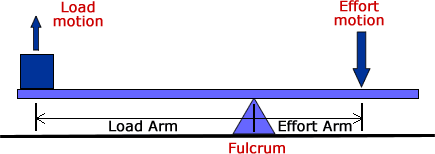
What lever class is this?
1
8
New cards
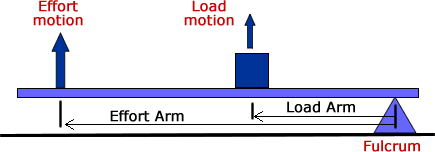
What lever class is this?
2
9
New cards
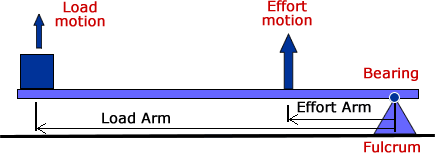
What lever class is this?
3
10
New cards
Give an example of a Class 1 Lever
Scissors
11
New cards
Give an example of a Class 2 Lever
A wheelbarrow
12
New cards
Give an example of a Class 3 Lever
A stapler
13
New cards
Describe what thermochromic pigments are
Thermochromic pigments change colour when their temperature changes. The term ‘thermo’ relates to heat, and chroma means colour - so thermochromic pigments change colour when they are heated up. These pigments can be mixed with paint or polymers to give the materials the same colour-changing properties as the pigment. An example of this technology is seen on colour-changing mugs or bath items for children.
14
New cards
What is a 'smart material’?
A material whose physical properties change in response to an input.
15
New cards
What is a ‘modern material’?
A material that has been engineered to have improved properties.
16
New cards
What is ‘graphene’?
Graphene is a single carbon layer material, which is hypothetically 100 times stronger than steel. It is hypothetical because we are yet to manufacture it in large enough quantities to prove this.
17
New cards
What is titanium used for? Why?
It is used in sporting and medical applications, such as replacement hip joints and high-performance bicycles. It is an excellent material for these purposes as it has a high strength-to-weight ratio and is resistant to corrosion.
18
New cards
What is ‘metal foam’
Metal foams are a strong but lightweight modern material produced by injecting a gas or foaming agent into molten metal. Typically, only 5-25 per cent of the foam is metal, and this allows the material to retain much of its strength but without the density or weight of solid metal. Metal foams are often used in vehicles such as planes and cars as they absorb shock effectively if the vehicle crashes.
19
New cards
What is an ‘LCD’?
Liquid crystal displays (LCDs) use the light-modulating properties of liquid crystals to display an image. The liquid crystals are between a liquid and solid state. When charge is applied to each liquid crystal, the shape changes to either block light or let light through. This ensures text or images display on the LCD.
20
New cards
How small are nanomaterials?
1 to 100 nanometres
21
New cards
What are ‘shape-memory alloys’?
Shape-memory alloys (SMA) are metal alloys that can remember their shape when heated. These alloys have been utilised on spectacle frames that spring back to shape if they are squashed.
22
New cards
What are ‘photographic pigments’?
Photochromic pigments change their properties when exposed to ultraviolet (UV) light. A well-known example would be glasses where the lenses are clear when worn inside a building, but become more like sunglasses when exposed to the bright sunlight outside. The same technology has been used in windows to prevent rooms from getting too hot in warm weather.
23
New cards
What is ‘QTC’?
Quantum-tunnelling composite (QTC) is an insulating rubber containing tiny particles of metal. When squashed, the metal particles meet and allow the flow of electrical current. As a result, QTC is an insulator when resting and a conductor when pressure is applied. It is often used in outdoor applications where water might otherwise damage tiny micro switches. It has been used in clothing to control smartphones and portable music players, in power tools to give variable speed controls and in touch-sensitive pads.
24
New cards
What two types of polymers are there?
Thermoforming and thermosetting
25
New cards
What type of polymer is ‘acrylic’?
Thermoforming
26
New cards
What are most polymers made from?
Crude oil: A mixture of hydrocarbons, mainly alkanes, formed over millions of years from the remains of ancient dead marine organisms.
27
New cards
What is ‘batch production’?
Where one group of identical products is made at the same time, before moving onto producing the next group.
28
New cards
What is ‘continuous production’?
A production method that leads to many of the same product being made, continuously.
29
New cards
What is ‘mass production’?
When the same product is manufactured many times.
30
New cards
What would a material’s ‘working properties’ relate to?
How it behaves in different environments when subjected to changing conditions, e.g. force or temperature changes.
31
New cards
What is ‘tolerance’?
The amount by which a measurement can vary without affecting the ability of the product to be manufactured accurately.
32
New cards
What is the difference between ‘thermoforming’ and ‘thermosetting’ polymers?
Thermoforming plastics can be reformed when heated, and therefore can often be recycled. Thermosetting polymers can only be formed once as they cannot be reheated and therefore cannot be recycled.
33
New cards
Name 4 stock forms of timber
Dowel
Planks
Logs
Sheets
Planks
Logs
Sheets
34
New cards
Name 7 hardwoods
* beech
* mahogany
* oak
* balsa
* jelutong
* birch
* ash
* mahogany
* oak
* balsa
* jelutong
* birch
* ash
35
New cards
Describe hardwood trees
Hardwood comes from deciduous trees with broad leaves. Hardwood trees take a long time to grow, around 60 years (sometimes up to 100). This means that they are rarely planted and are very expensive. The majority of hardwoods grow in tropical regions, such as Amazonian climates, while others grow in temperate climates such as Europe. Their growth rings are much smaller than softwood, making the grain closer.
36
New cards
Describe softwood trees
Softwood comes from coniferous trees with needle-like leaves that normally stay on during the winter - larch is an exception as it loses its needle-like leaves during the winter. Softwoods naturally grow in colder regions such as Alpine climates. Softwood trees grow quickly so their growth rings are wider making the grain wider. This ability to grow quickly means that softwood trees can be used for timber after 20-30 years - making them cheaper than hardwood.
37
New cards
Name 3 softwoods
* pine
* cedar
* larch
* cedar
* larch
38
New cards
How are manufactured boards made?
Manufactured timbers can be made from leftover wood such as sawdust and wood chippings. This means they can be made into large sheets rather than being restricted to the size of a tree trunk. They are much cheaper than both hardwoods and softwoods and are often used in low-cost furniture.
39
New cards
Name 3 manufactured boards
* medium-density fibreboard (MDF)
* plywood
* chipboard
* plywood
* chipboard
40
New cards
What is a ‘knot’?
A knot in timber marks where a branch once grew out on the tree. Knots often fall out from planks as they shrink, leaving a hole. It is preferable to use timber without knots, unless for a decorative purpose.
41
New cards
Name the 6 R’s
Reduce, reuse, recycle, refuse, rethink, repair
42
New cards
Name 6 finishes
* staining
* varnishing
* oiling
* waxing
* painting
* shellacking
* varnishing
* oiling
* waxing
* painting
* shellacking
43
New cards
A piece of oak costs £1,700 per m^3 and the piece to be valued is 1,000 mm × 50 mm × 250 mm. Calculate the price.
£21.25
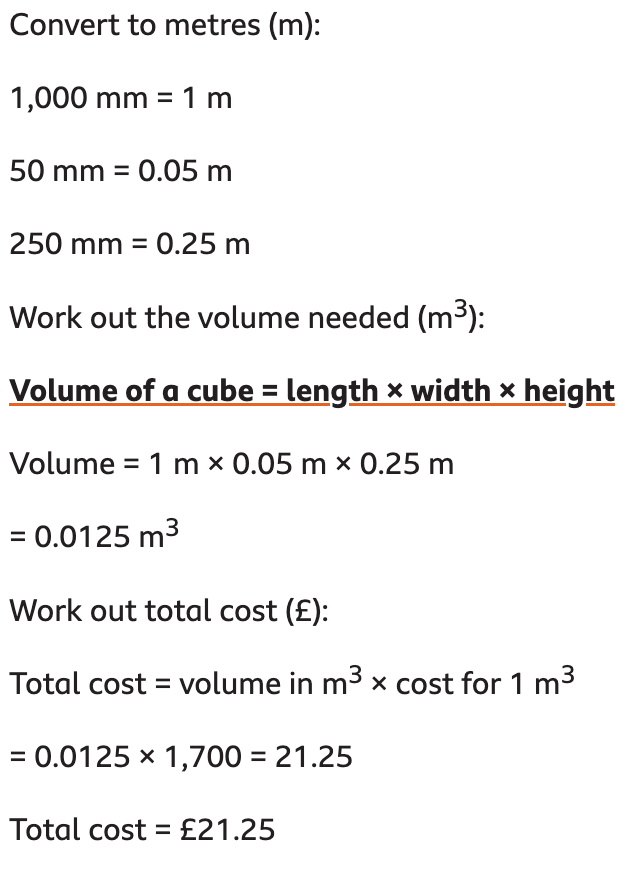
44
New cards
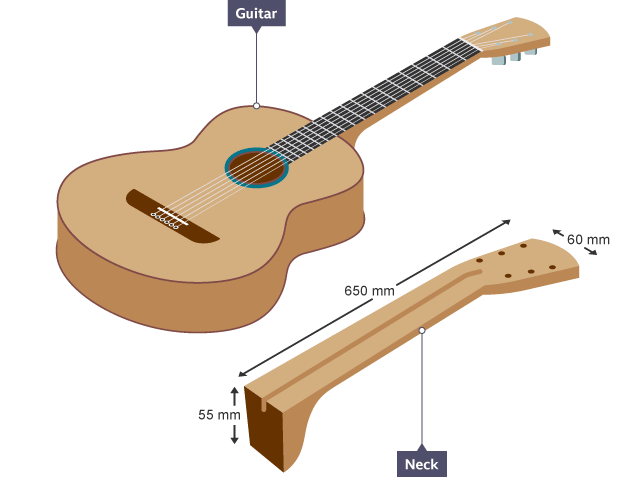
A plank of ash will be used in the design of a guitar body. It costs £1,850.00 per m^3 and the neck design requires 650 mm × 60 mm × 55 mm. Calculate the cost of the neck section.
£3.96

45
New cards
Name and describe the 5 forces
* tension - a pulling force
* compression - a pushing force
* bending - forces at an angle to the material
* torsion - a twisting force
* shear - forces acting across the material
* compression - a pushing force
* bending - forces at an angle to the material
* torsion - a twisting force
* shear - forces acting across the material
46
New cards
What does ‘CADCAM’ stand for?
Computer-aided design, computer-aided manufacure
47
New cards
What is a laminate?
A thin layer of material
48
New cards
What is a veneer?
A thin layer of wood
49
New cards
How many layers does plywood have?
An odd number, at 90º to each other
50
New cards
Name 7 wood joints, and list the advantages and disadvantages of each
\
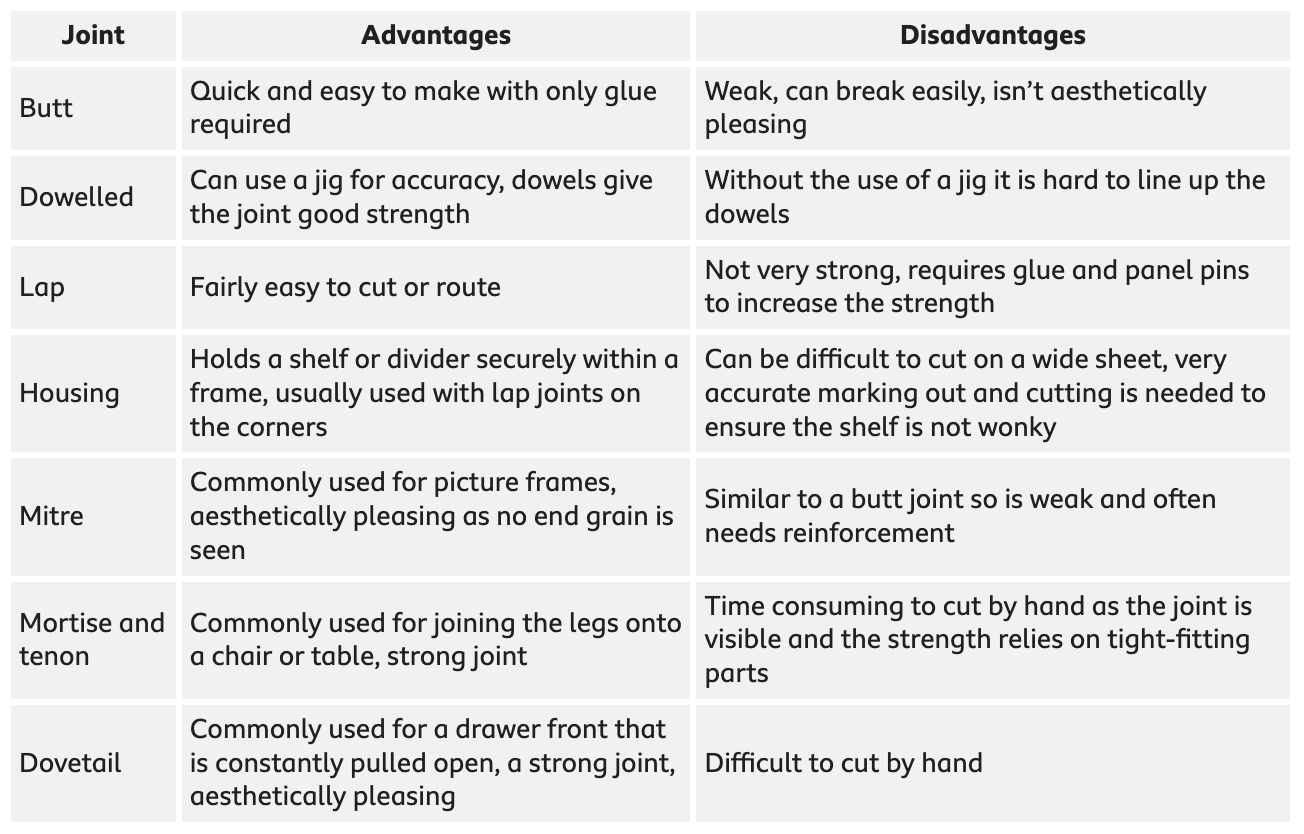
51
New cards
What are the 3 types of paint?
Glossy matt and silk
52
New cards
How do wood stains work?
Wood stain is applied so that the appearance of the timber is enhanced. It is possible to buy many different wood stains that are designed to look like a different wood type. Often, pine is stained to look like a darker hardwood - hardwood is expensive, so staining a piece of cheaper timber is often a good alternative. The wood stain gives some protection to the timber, but an additional coat of varnish after staining is often a good idea.
53
New cards
When are oil and wax used on timbers?
Oil and wax soak into timber and can be used to enhance the natural appearance of the timber. Often kitchen worktops and chopping boards are oiled or waxed so that the surface repels water.
54
New cards
How is varnish used on timber?
Varnish can be applied to timber so that a shiny appearance is achieved. Varnish is usually applied in many layers so that the thickness of the varnish is more durable. Varnish can be glossy or matt depending on the type used.
55
New cards
What is ‘shellac’?
Shellac is a resin secreted by a beetle. Several layers are built by rubbing the polish on to create a finish called French polish. It tends to be used on expensive furniture to give it a glossy shine but can be easily damaged by heat and water.